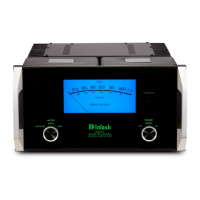16
Under normal operating
conditions, there are no
differences between the
shape of these waveforms.
If the amplifier is over-
driven, there will be a
difference between the
two signal waveforms.
When the difference
exceeds 0.3%, the Power
Guard activates the PG
light and a dynamic
electronic attenuator
at the amplifier input
reduces the input volume
just enough to prevent
any further increase in
distortion. The Power
Guard circuit acts so fast
that there are absolutely
no audible side effects
and the sonic purity of
the music reproduction is
perfectly preserved. The
MC601 Power Amplifier
with Power Guard is not
limited to just the rated
power output, but will actually produce distortion free
output well above its rated power due to the McIntosh
philosophy of conservative design.
Power Supply Circuits
To compliment the design of the MC601 Power Am-
plifier Circuitry, there is a high current high voltage
ing conditions. The
different types of
protection circuits
incorporated in
the MC601 insure
a long and safe
operating life. This
is just one of the
many character-
istics of McIntosh
Power Amplifiers
that make them
world famous.
The MC601 also includes the unique patented
McIntosh Power Guard
circuit. Power Guard
eliminates the possibility
of ever overdriving the
amplifier into clipping.
Refer to figures 19, 20
and 21. An overdriven
amplifier can produce
both audible and inau-
dible distortion levels
exceeding 40%. The
audible distortion is
unpleasant to hear, but
the inaudible ultrasonic
distortion is also undesirable, since it can damage
valuable loudspeaker system tweeters. You will never
experience the harsh and damaging distortion due to
clipping.
The Power Guard circuit is a waveform compara-
tor, monitoring both the input and output waveforms.
Figure 20
Without Power Guard
Figure 19
Input Test Signal
(14kHz & 15kHz)
Figure 21
With Power Guard
Figure 18
Power Output Meter
The McIntosh MC601 has a large Output Watt Me-
ter that responds 95% full scale to a single cycle tone
burst at 2kHz. Refer to figure 17. Voltage and current
outputs
are elec-
tronically
measured,
multiplied
and fed to
a special
circuit that
accelerates
the pointer
move-
ment in
the upward
direction.
Refer to figure 25 on the next page. When the pointer
reaches its peak it pauses only long enough for the
human eye to perceive its position, then drops. It is
almost 10 times faster than a professional VU meter.
A front panel switch is provided to change the
meter to the Watts Hold Mode of operation. This al-
lows fast upward movement of the pointer but greatly
increases Hold Time at the peak of its travel. The
highest power output of the source material is thus
recorded.
Protection Circuits
The MC601 incorporates the McIntosh Sentry Monitor
Output Transistor Protection Circuit. Refer to Figure
18. There is absolutely no compromise in sonic perfor-
mance with this circuit, and it ensures safe operation
of the amplifier under even the most extreme operat-
Technical Description, con’t
Figure 17

